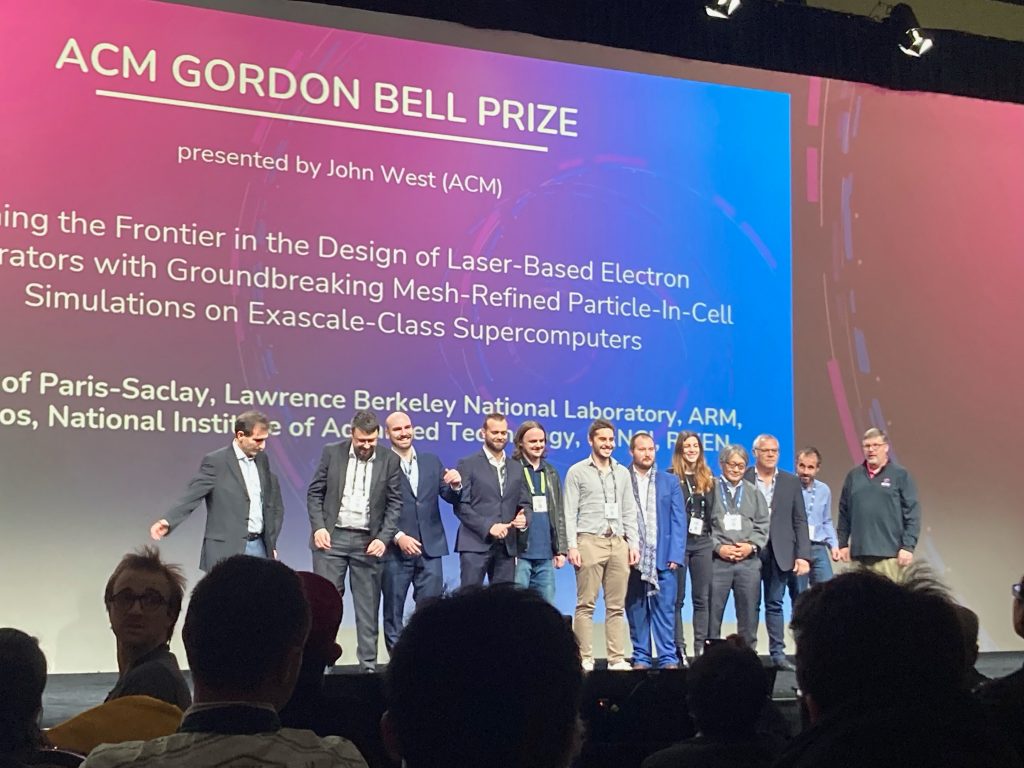A 16-member team of researchers from Lawrence Berkeley National Laboratory (Berkeley Lab), Lawrence Livermore National Laboratory, and the French Alternative Energies and Atomic Energy Commission (CEA) won the Association for Computing Machinery’s (ACM’s) 2022 Gordon Bell Prize today for its simulation code, WarpX. It is the first mesh-refined, particle-in-cell code for kinetic plasma simulations that is optimized for parallel computing. And now, it is the first Gordon Bell Prize winner to have been run on the Oak Ridge Leadership Computing Facility’s (OLCF’s) new exascale-class supercomputer, Frontier.
The ACM Gordon Bell Prize is awarded to recognize outstanding achievement in high-performance computing. The team received their prize at the 2022 International Conference for High Performance Computing, Networking, Storage, and Analysis, or SC22, in Dallas, Texas.
Granted early access to the world’s fastest supercomputer, the WarpX team used Frontier’s exascale power (2 billion-billion floating point operations per second of theoretical peak performance) for their submission to the Gordon Bell competition. Led by Jean-Luc Vay, a senior scientist at Berkeley Lab, the team produced a 3D simulation at scale of their own novel concept: a combined plasma particle injector and accelerator that focuses a high-power femtosecond (1 quadrillionth of a second) laser onto a hybrid solid/gas target.
Such plasma-based particle accelerators were first proposed more than 40 years ago to investigate more compact accelerators for high-energy physics experimentation. Scientists posited that shooting a charged particle beam or laser through a low-density plasma would displace the particles, thereby creating an electric field to accelerate electron or positron beams in a much shorter distance than in conventional radio-frequency accelerators. This process could result in smaller, cheaper accelerators for science. WarpX may speed up development of plasma accelerator technology.
“It’s really hard to get experimental diagnostics of what’s happening in high-intensity, laser-matter interactions,” said Henri Vincenti, a core member of the WarpX team and CEA’s head of theory and modeling in its Physics at High Intensity (PHI) group. “We don’t have analytical tools or experimental diagnostics that are accurate enough to capture the physical phenomena at play in the laser-matter interaction, so we need high-fidelity numerical tools like WarpX.”

The WarpX team receiving its ACM Gordon Bell Prize at SC22. Photo by Betsy Sonewald/ORNL
As part of the Exascale Computing Project (ECP), the team optimized WarpX to run on some of the world’s fastest supercomputers—ORNL’s Frontier and Summit, Berkeley Lab’s Perlmutter, and Fugaku at the Riken Center for Computational Science in Kobe, Japan—despite their different architectures. Combined with the software’s adaptive mesh refinement—the ability to refine the resolution only in a certain region of the simulation grid to increase the speed and accuracy of its calculations—this optimization makes WarpX capable of much faster, lower-cost, higher-fidelity 3D models of laser-matter interactions than current codes. The team reported that WarpX runs 500× faster than the previous version of the code, Warp, since they began working on their ECP project 6 years ago.
The team’s paper, “Pushing the Frontier in the Design of Laser-Based Electron Accelerators With Groundbreaking Mesh-Refined Particle-In-Cell Simulations on Exascale-Class Supercomputers,” can be found on the ACM Gordon Bell Prize webpage.
Frontier is an HPE-Cray EX system with more than 9,400 nodes, each equipped with a third-generation AMD EPYC CPU and four AMD Instinct MI250X graphics processing units, or GPUs. The OLCF is a US Department of Energy (DOE) Office of Science user facility located at the DOE’s Oak Ridge National Laboratory.
UT-Battelle LLC manages ORNL for DOE’s Office of Science, the single largest supporter of basic research in the physical sciences in the United States. DOE’s Office of Science is working to address some of the most pressing challenges of our time. For more information, visit https://energy.gov/science.





